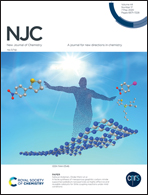Ligand conformations and spin states in sandwich-type complexes of the split (3+2) five-electron donor hydrocarbon ligand bicyclo[3.2.1]octa-2,6-dien-4-yl (bcod)†
Abstract
The geometries and energetics of the bis(bicyclo[3.2.1]octa-2,6-dien-4-yl) complexes of the first row transition metals, (bcod)2M (M = Ti to Cu), including the experimentally known chromium and iron derivatives, have been examined by density functional theory. Sandwich-type structures in which each bcod ligand is bonded to the central metal atom through both the trihapto allylic unit and the double bond are energetically preferred for the metals from titanium to iron. However, higher energy (bcod)2M (M = V, Cr, Mn) isomers are found in which one of the bcod ligands is bonded to the central metal atom through the trihapto allylic unit and an agostic hydrogen from the CH2 bridge leaving an uncomplexed C![[double bond, length as m-dash]](https://www.rsc.org/images/entities/char_e001.gif) C double bond. The experimentally known iron complex (bcod)2Fe, an analogue of ferrocene, has the favored 18-electron configuration and a singlet spin state. For the metals to the left of iron from manganese to vanadium the energetically preferred spin states range from doublet to quartet, respectively, corresponding to holes in the closed shell 18-electron configuration. However, a singlet structure is preferred for (bcod)2Ti despite the 14-electron configuration of the central titanium atom. The (bcod)2M (M = Co, Ni, Cu) derivatives of the electron richer later transition metals are characterized by several structures of different types at closely spaced energies in which at least one of the bcod ligands is only partially bonded to the central metal atom.
C double bond. The experimentally known iron complex (bcod)2Fe, an analogue of ferrocene, has the favored 18-electron configuration and a singlet spin state. For the metals to the left of iron from manganese to vanadium the energetically preferred spin states range from doublet to quartet, respectively, corresponding to holes in the closed shell 18-electron configuration. However, a singlet structure is preferred for (bcod)2Ti despite the 14-electron configuration of the central titanium atom. The (bcod)2M (M = Co, Ni, Cu) derivatives of the electron richer later transition metals are characterized by several structures of different types at closely spaced energies in which at least one of the bcod ligands is only partially bonded to the central metal atom.
![Graphical abstract: Ligand conformations and spin states in sandwich-type complexes of the split (3+2) five-electron donor hydrocarbon ligand bicyclo[3.2.1]octa-2,6-dien-4-yl (bcod)](/en/Image/Get?imageInfo.ImageType=GA&imageInfo.ImageIdentifier.ManuscriptID=D0NJ00542H&imageInfo.ImageIdentifier.Year=2020)


 Please wait while we load your content...
Please wait while we load your content...